Compensation for the Lack of Measured Data on Decisive Cultivation Conditions in Diversified Territories without Losing Correct Information
Abstract
:1. Introduction
- If we have exactly defined morphometric, soil, and other invariable factors that determine the conditions for variables on a given site, then it is obvious that the same basic climate and hydrologic conditions should occur on all sites with the same values of invariable factors;
- Accordingly, the measured climatic and other data on a site with defined invariables should be valid for all other sites with the same values of invariables in the same climatic region.
2. Materials and Methods
2.1. Method Basis
- They sufficiently define the varying thermal and moisture conditions, and;
- Objective mapping and definition of morpho-pedotop types:
- -
- Mapping of selected morphometric properties that influence insolation and slope dynamics;
- -
- Mapping of selected soil ecological properties;
- -
- The definition and mapping of morpho-pedotop types.
- Purpose-oriented interpretation of morpho-pedotops, which elucidates the characteristics of the micro-climate and soil moisture conditions on each territory unit, and;
- Spatial comparison of the micro-climate and soil moisture conditions on sites that have measuring devices and on all territory sites that lack them.
2.2. Study Area
2.3. Data: The Input Indices and Their Analyses
2.3.1. Spatial Frame and Cartographic Base—Digital Terrain Model (DTM)
2.3.2. Morphometric Indices
2.3.3. Morpho-Climatic Indices
2.3.4. Macroclimatic Data and Their Topic Interpretation
2.3.5. Abiocomplex: This Consolidates the Index Set of Soil, Relief, and Geology
2.3.6. Complex (Partial Synthetic) Indices
2.4. Syntheses and Interpretations
- Interpretation of micro-climate differences: The astronomic data, such as the sun trajectory on the orbit and its seasonal changes, are stable for the given climate and geographical region, and the differences in the microclimate are expressed basically by the diversity of the morphometric indices of the georelief—namely by slope angle, aspect, and shading. The differences were interpreted according to the amount of solar radiation on the relief surface [42,43]. The length timing and amount of direct sun radiation are summarised for each month, and for the entire 1 April to 31 October vegetation period.
- Definition of the tendency and direction of water and material movement on the base of the horizontal and profile curvature of relief forms. The horizontally concave curvature of the relief determines the concentrated, the uncurved relief the linear, and the convex relief the dispersed direction of the run-off. The profile concave curvature determines decelerated run-off, the non-curved portion equable run-off, and convex curvature indicates accelerated run-off.
- Definition of the balance of the water and material movement based on the topographic position and complex forms of relief. This determines movements from accelerated dispersed removal up to decelerated concentrated accumulation.
- Calculation of the amount of water arriving at the unit from surface or underground.
- Flow based on the size of the area above the evaluated unit; this is defined as the contributing area.
- Determination of the morpho-pedotop run-off index. This provides the rate of infiltrated and outflow water based on soil and slope architecture [44].
- Estimation of the aggregate morpho-pedotop water supply from the combination of the balance of the water movement and the size of the contributing area in the relative classes. These classes provide the input values for the interpretation of the moisture regime and the morphotop topographic humidity. This is illustrated by the vertical axis in Table 2.
- Determination of soil retention potential based on the soil type and texture defined in the following 1 to 8 graded scale, from 1—skeleton soils, sands, and other coarse materials that cause rapid soil infiltration and thus also quick drying out in extremely dry soils; up to: 7—wet, water-logged, gley, and sometimes salinated soils permanently influenced by underground water as extremely wet soils; 8—peat. The normal, and not extreme, soil types are ranked according to their texture from 2 to 6 on the horizontal axis in Table 2.
- Final determination of the moisture regime of the morpho-pedotops based on the combination of soil types and water supply in the relative 6-grade scale (Table 2).
3. Results
3.1. Microclimatic Conditions
3.2. Pedologic Conditions
3.3. Complex Interpretations: The Morpho-Pedotops’ Thermal–Moisture Regime
3.4. Comparisons and Interpolation
- These measured values determine phenologic phases and thus forecast disease formation and escalation, and they can suggest protective management decisions.
- This is a reasonable prediction that the time course of the phenologic and disease phases should be the same, or very similar, on each morpho-pedotop with the same exactly defined conditions as those on sensor sites.
- Thus, we can reasonably suggest that the time course for management actions should also be the same, or very similar, on each morpho-pedotop with the same exactly defined conditions as those on sensor sites, which are usually based on the measured microclimate date.
4. Discussion
5. Conclusions
- The analyses of the morphologic and pedologic conditions and their mapping on the whole study area. Their syntheses resulted in the definition of morpho-pedotops. These results have basic research character;
- The purpose-oriented morpho-pedotop interpretation projects the study area’s complex thermal and moisture conditions. Our results here have applied research character;
- The interpolation, comparison, and definition of the relative differences in objective thermal–moisture regime characteristics site-specific for the entire territory. This provides the basis for sustainable field management, which can transform research results into appropriate agricultural practice. This part of our result has practical character.
Author Contributions
Funding
Conflicts of Interest
References
- Schieffer, J.; Dillon, C. The economic and environmental impacts of precision agriculture and interactions with agro-environmental policy. Precis. Agric. 2015, 16, 46–61. [Google Scholar] [CrossRef]
- Mcbratney, A.; Whelan, B.; Ancev, T. Future Directions of Precision Agriculture. Precis. Agric. 2005, 6, 7–23. [Google Scholar] [CrossRef]
- Qin, C.Z.; Zhu, A.X.; Pei, T.; Li, B.L.; Scholten, T.; Behrens, T.; Zhou, C.H. An approach to computing topographic wetness index based on maximum downslope gradient. Precis. Agric. 2011, 12, 32–43. [Google Scholar] [CrossRef]
- Kerényi, A.; Csorba, P. Assessment of the sensitivity of the landscape in a sample area in Hungary for climatic variability. Earth Surf. Process. Landf. 1991, 16, 663–673. [Google Scholar] [CrossRef]
- Hreško, J.; Boltižiar, M. The influence of the morphodynamic processes to landscape structure in the high mountains (Tatra Mts.). Ecology 2001, 20, 141–149. [Google Scholar]
- Wrbka, T.; Erb, K.H.; Schulz, N.B.; Peterseil, J.; Hahn, C.O.; Haberl, H. Linking pattern and process in cultural landscapes. An empirical study based on spatially explicit indicators. Land Use Policy 2004, 21, 289–306. [Google Scholar] [CrossRef]
- Jongman, R.H. Homogenisation and fragmentation of the European landscape: Ecological consequences and solutions. Landsc. Urban Plan. 2002, 58, 211–221. [Google Scholar] [CrossRef]
- Antrop, M. Background concepts for integrated landscape analysis. Agric. Ecosyst. Environ. 2000, 77, 17–28. [Google Scholar] [CrossRef]
- Bastian, O.; Krönert, R.; Lipský, Z. Landscape Diagnosis on Different Space and Time Scales—A Challenge for Landscape Planning. Landsc. Ecol. 2006, 21, 359–374. [Google Scholar] [CrossRef]
- Mizgajski, A.; Markuszewska, I. (Eds.) Implementation of landscape ecological knowledge in practice. In The Problems of Landscape Ecology; Polish Association for Landscape Ecology, Wydawnictvo Naukowe Adam Miczkiewicz University: Poznań, Poland, 2010; Volume 28, p. 271. [Google Scholar]
- AGENDA 2l. Integrated Approach to the management of Land resources. In Proceedings of the United Nations Conference on Environment and Development, Rio de Janeiro, Brazil, 3–14 June 1992. Chapter 10. [Google Scholar]
- Izakovičová, Z.; Miklós, L.; Miklósová, V. Integrative assessment of land use conflicts. Sustainability 2018, 10, 3270. [Google Scholar] [CrossRef] [Green Version]
- Pacheco, F.A.L. Sustainable Use of Soils and Water: The Role of Environmental Land Use Conflicts. Sustainability 2020, 12, 1163. [Google Scholar] [CrossRef] [Green Version]
- Reed, J.; Van Vianen, J.; Barlow, J.; Sunderland, T. Have integrated landscape approaches reconciled societal and environmental issues in the tropics? Land Use Policy 2017, 63, 481–492. [Google Scholar] [CrossRef]
- Band, L.; Tagu, C.; Brun, S.; Tenenbaum, D.; Fernandez, R. Modelling watersheds as spatial object hierarchies: Structure and dynamics. Trans. GIS 2000, 4, 181–196. [Google Scholar] [CrossRef]
- Belčáková, I. New approaches to the integration of ecological-social and economic aspects in land use planning. Ekológia 2003, 22, 183–189. [Google Scholar]
- Behrens, T.; Scholten, T. Digital Soil mapping in Germany—A review. J. Plant. Nutr. Soil Sci. 2006, 169, 434–443. [Google Scholar] [CrossRef]
- Schmidt, K.; Behrens, T.; Friedrich, K.; Scholten, T. A method to generate soilscapes from soil maps. J. Plant. Nutr. Soil Sci. 2010, 173, 163–172. [Google Scholar] [CrossRef]
- Howard, J.A.; Mitchell, C.W. Phytogeomorphology; Wiley: New York, NY, USA, 1985. [Google Scholar]
- Miklós, L. Morphometric indices of the relief in the LANDEP methods and their interpretation. Ecology (Czechoslovak Federative Republic) 1991, 10, 159–186. [Google Scholar]
- Pauditšová, E.; Slabeciusová, B. Modelling as a platform for landscape planning. In Proceedings of the 14th International Multidisciplinary Scientific GeoConferences SGEM 2014, Albena, Bulgaria, 17–26 June 2014; Volume 3, pp. 753–760. [Google Scholar]
- Falťan, V.; Pírová, L.; Petrovič, F. Detailed mapping of geocomplexes in the vineyard landscape. Folia Oecologica 2016, 43, 138–146. [Google Scholar]
- Krcho, J. Georelief as a subsystem of landscape and the influence of morphometric parameters of georelief on spatial differentiation of landscape-ecological processes. Ecology 1991, 10, 115–158. [Google Scholar]
- Miklós, L.; Kočická, E.; Izakovičová, Z.; Kočický, D.; Špinerová, A.; Diviaková, A.; Miklósová, V. Landscape as a Geosystem; Springer: Cham, Switzerland, 2019; p. 161. [Google Scholar] [CrossRef]
- Brath, A.; Montanari, A. The effects of the spatial variability of soil infiltration capacity in distributed rainfall-runoff modelling. Hydrol. Process. 2000, 14, 2779–2794. [Google Scholar] [CrossRef]
- Csorba, P. Landscape ecological fragmentation of the small landscape units (Microregions) of Hungary based on the settlement network and traffic infrastructure. Ecology 2008, 27, 99–116. [Google Scholar]
- Súľovský, M.; Falťan, V.; Skokanová, H.; Havlíček, M.; Petrovič, F. Spatial analysis of long-term land-use development regarding physiotopes: Case studies from the Carpathians. Phys. Geogr. 2017, 38, 470–488. [Google Scholar] [CrossRef]
- Łowicki, D.; Mizgajski, A. Typology of physical-geographical regions in Poland in line with land-cover structure and its changes in the years 1990–2006. Geogr. Pol. 2013, 86, 255–266. [Google Scholar] [CrossRef]
- Bastian, O.; Grunewald, K.; Khoroshev, A.V. The significance of geosystem and landscape concepts for the assessment of ecosystem services: Exemplified in a case study in Russia. Landsc. Ecol. 2015, 30, 1145–1164. [Google Scholar] [CrossRef]
- Reina, G. A multi-sensor robotic platform for ground mapping and estimation beyond the visible spectrum. Precis. Agric. 2019, 20, 423–444. [Google Scholar] [CrossRef]
- Hreško, J.; Mederly, P.; Petrovič, F. Landscape ecological research with the support of GIS tools in the preparation of landscape-ecological plan (model area of the Považská Bystrica city). Ecology 2013, 22, 195–212. [Google Scholar]
- Field, D.; Morgan, C.L.S.; Mcbratney, A.B. (Eds.) Global Soil Security (Progress in Soil Science), 1st ed.; Springer: Cham, Switzerland, 2017. [Google Scholar] [CrossRef]
- Morgan, C.L.S.; Yimam, Y.T.; Barlage, M.; Gochis, D.; Dornblaser, B. Valuing of Soil Capability in Land Surface Modelling. In Global Soil Security; Springer: Cham, Switzerland, 2017. [Google Scholar] [CrossRef]
- Jarvis, A.; Reuter, H.; Nelson, A.; Guevara, E. Hole-Filled SRTM for the Globe: Version 4: Data Grid. CGIAR Consortium for Spatial Information. 2008. Available online: http://srtm.csi.cgiar.org/ (accessed on 4 November 2013).
- Burrough, P.A.; Mcdonnel, R.A. Principles of Geographical Information Systems; Oxford University Press: Oxford, UK, 1998. [Google Scholar]
- Tarboton, D.G. A new method for the determination of flow directions and upslope areas in grid digital elevation models. Water Resour. Res. 1997, 33, 309–319. [Google Scholar] [CrossRef] [Green Version]
- Costa-Cabral, M.C.; Burges, S.J. Digital Elevation Model Networks (Demon): A Model of Flow Over Hillslopes for Computation of Contributing and Dispersal Areas. Water Resour. Res. 1994, 30, 1681–1692. [Google Scholar] [CrossRef]
- Mazúr, E. (Ed.) Atlas of the Slovak Socialist Republic; SAV, SÚGK: Bratislava, Slovakia, 1980. [Google Scholar]
- Malíšek, F. Optimisation of the slope lengths in relation to the water erosion. Bratislava. Ved. Práce VÚPÚ 1992, 17, 201–220. [Google Scholar]
- Šúri, M. The Mapping and Modelling of the Water Erosion with the Remote Sensing Data in GIS; Geografický Ústav Slovenskej Akadémie Vied [Geographical Institute of the Slovak Academy of Sciences]: Bratislava, Slovakia, 1990. [Google Scholar]
- Blaney, H.F.; Cridle, W.D. Determining Water Requirements in Irrigated Areas from Climatological and Irrigation Data; Soil Conservation Service: Washington, DC, USA, 1950; p. 48. [Google Scholar]
- Fu, P.; Rich, P.M. The Solar Analyst 1.0 Manual. US Helios Environmental Modelling Institute (HEMI). 2000. Available online: http://citeseerx.ist.psu.edu/viewdoc/download (accessed on 14 February 2014).
- Fu, P.; Rich, P.M. A Geometric Solar Radiation Model with Applications in Agriculture and Forestry. Comput. Electron. Agric. 2002, 37, 25–35. [Google Scholar] [CrossRef]
- Kim, H.S. Soil Erosion Modelling Using RUSLE and GIS; Colorado State University: Fort Collins, CO, USA, 2006. [Google Scholar]
- Whelan, B.M.; Mcbratney, A.B. Definition and Interpretation of potential management zones in Australia. In Proceedings of the 11th Australian Agronomy Conference, Geelong, Victoria, Australia, 2–6 February 2003. [Google Scholar]
- Mizgajski, A.; Stępniewska, M. Ecosystem services assessment for Poland—Challenges and possible solutions. Ekonomia i Środowisko 2012, 2, 54–73. [Google Scholar]
- La Rosa, D.; Priviteram, R. Characterization of non-urbanized areas for land-use planning of agricultural and green infrastructure in urban contexts. Landsc. Urban. Plan. 2013, 109, 94–106. [Google Scholar] [CrossRef]
- Štefunková, D.; Hanušin, J. Viticultural landscapes: Localised transformations over the past 150 years through an analysis of three case studies in Slovakia Institute of Landscape Ecology of the Slovak Ac. Morav. Geogr. Rep. 2019, 27, 155–168. [Google Scholar]
- Belmans, C.; Wesseling, J.G.; Feddes, R.A. Simulation model of the water balance of a cropped soil: SWATRE. J. Hydrol. 1983, 63, 271–286. [Google Scholar] [CrossRef]
- De Roo, A.; Thielen, J.; Gouweleuuw, B.; Lisflood, A. Distributed Water-Balance, Flood Simulation and Flood Inundation Model; User Manual Version 1.0; Report of the European Commission; Joint Research Centre: Ispra, Italy, Special Publications No. I.02.131; 2002. [Google Scholar]
- La Rosa, D.; Barbarossa, L.; Privitera, R.; Martinico, F. Agriculture and the city: A method for sustainable planning of new forms of agriculture in urban contexts. Land Use Policy 2014, 41, 290–303. [Google Scholar] [CrossRef]
- Jongman, R.H. (Ed.) The New Dimensions of the European Landscapes; Springer Science & Business Media: Dordrecht, Holland, 2004; p. 258. [Google Scholar]
- Breuste, J.; Haase, D. Workshop 2: Challenges for urban landscape in Europe. In European Landscapes in Transformation: Challenges for Landscape Ecology and Management, Proceedings of the European IALE Conference, Salzburg, Austria, 12–46 July 2009; Breuste, J., Kozová, M., Finka, M., Eds.; Salzburg: Bratislava, Slovakia, 2009; pp. 516–521. ISBN 978-80-227-3100-3. [Google Scholar]
- Kaspar, T.C.; Colvin, T.S.; Jaynes, B.; Karlen, D.L.; James, D.E.; Meek, D.W. Relationship between six years of corn yields and terrain attributes. Precis. Agric. 2003, 4, 87–101. [Google Scholar] [CrossRef]
- Slámová, M.; Belčáková, I. The role of small farm activities for the sustainable management of agricultural landscapes: Case studies from Europe. Sustainability 2019, 11, 5966. [Google Scholar] [CrossRef] [Green Version]
- Izakovičová, Z.; Miklós, L.; Špulerová, J. Basic principles of sustainable land use management. In Current Trends in Landscape Research: Innovations in Landscape Research; Springer Nature: Cham, Switzerland, 2019; pp. 395–423. [Google Scholar]
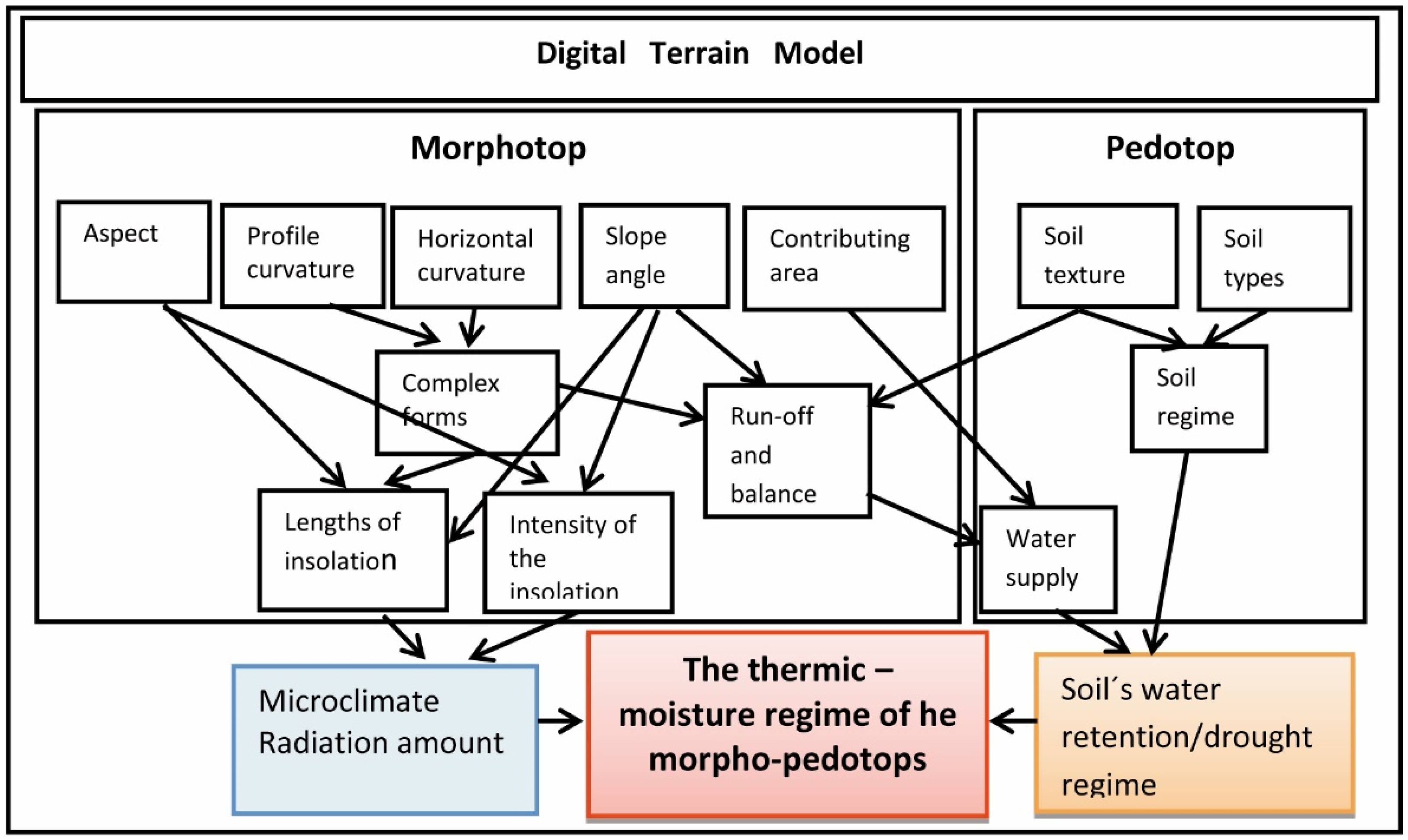
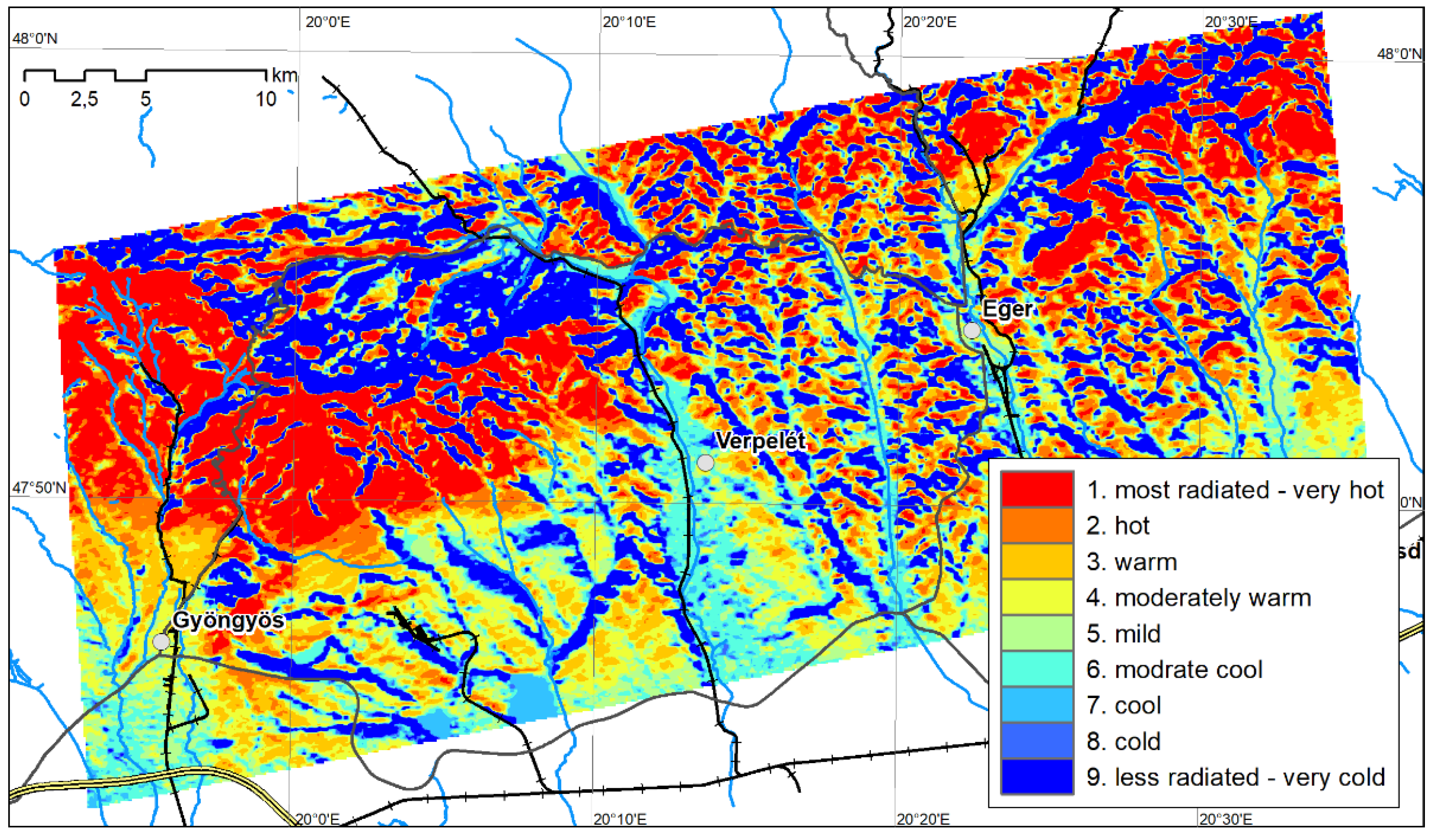

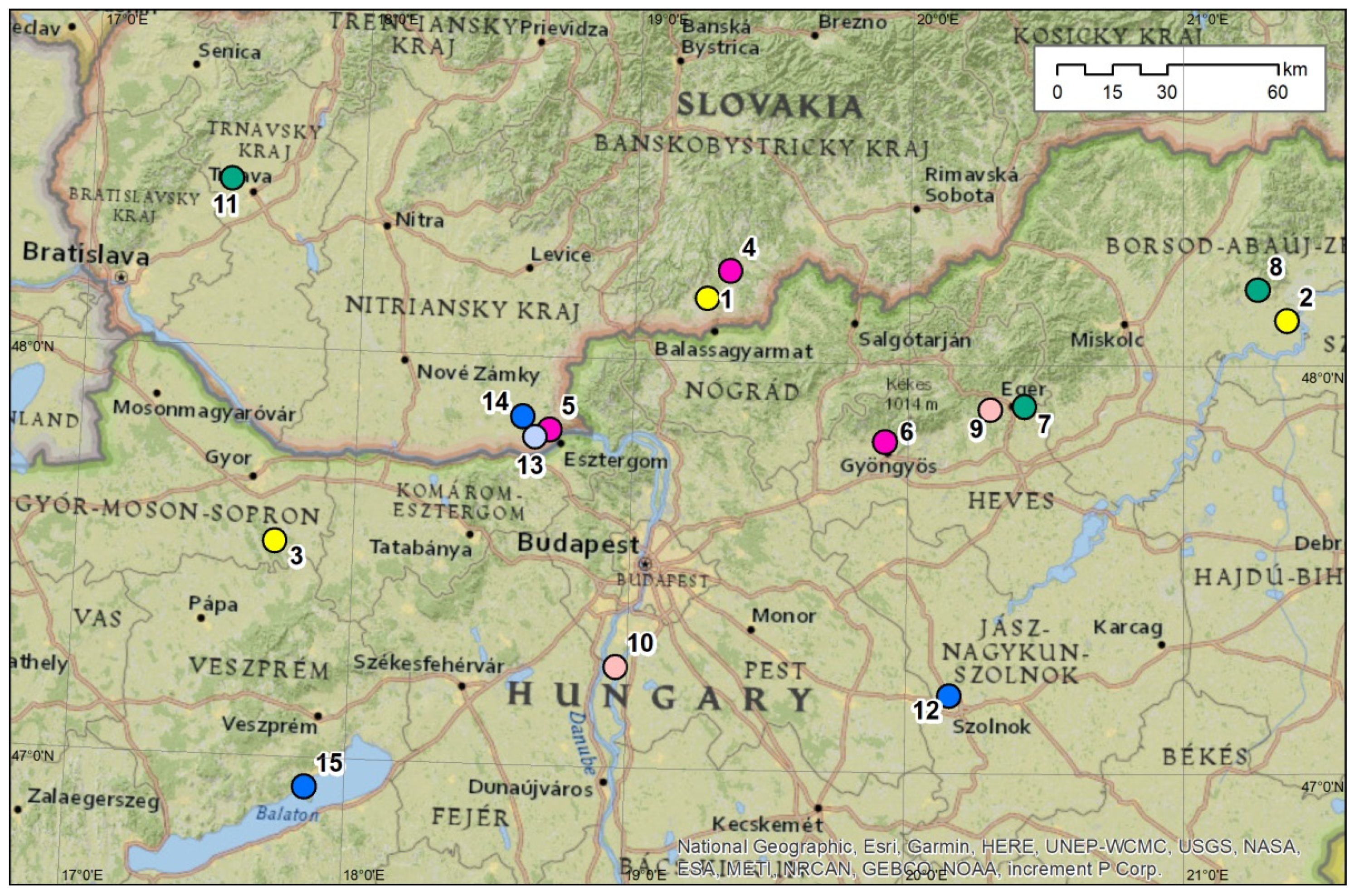
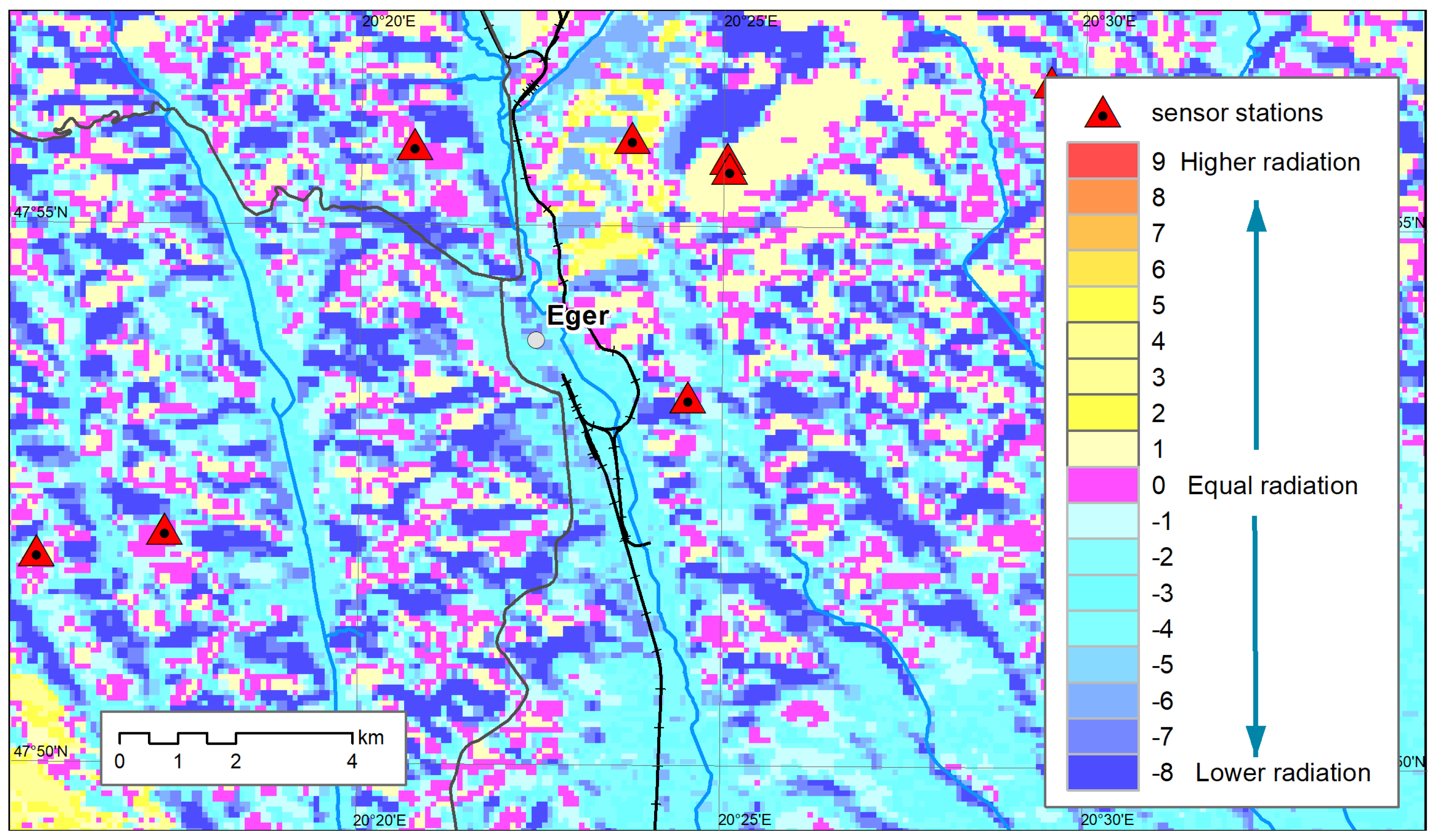
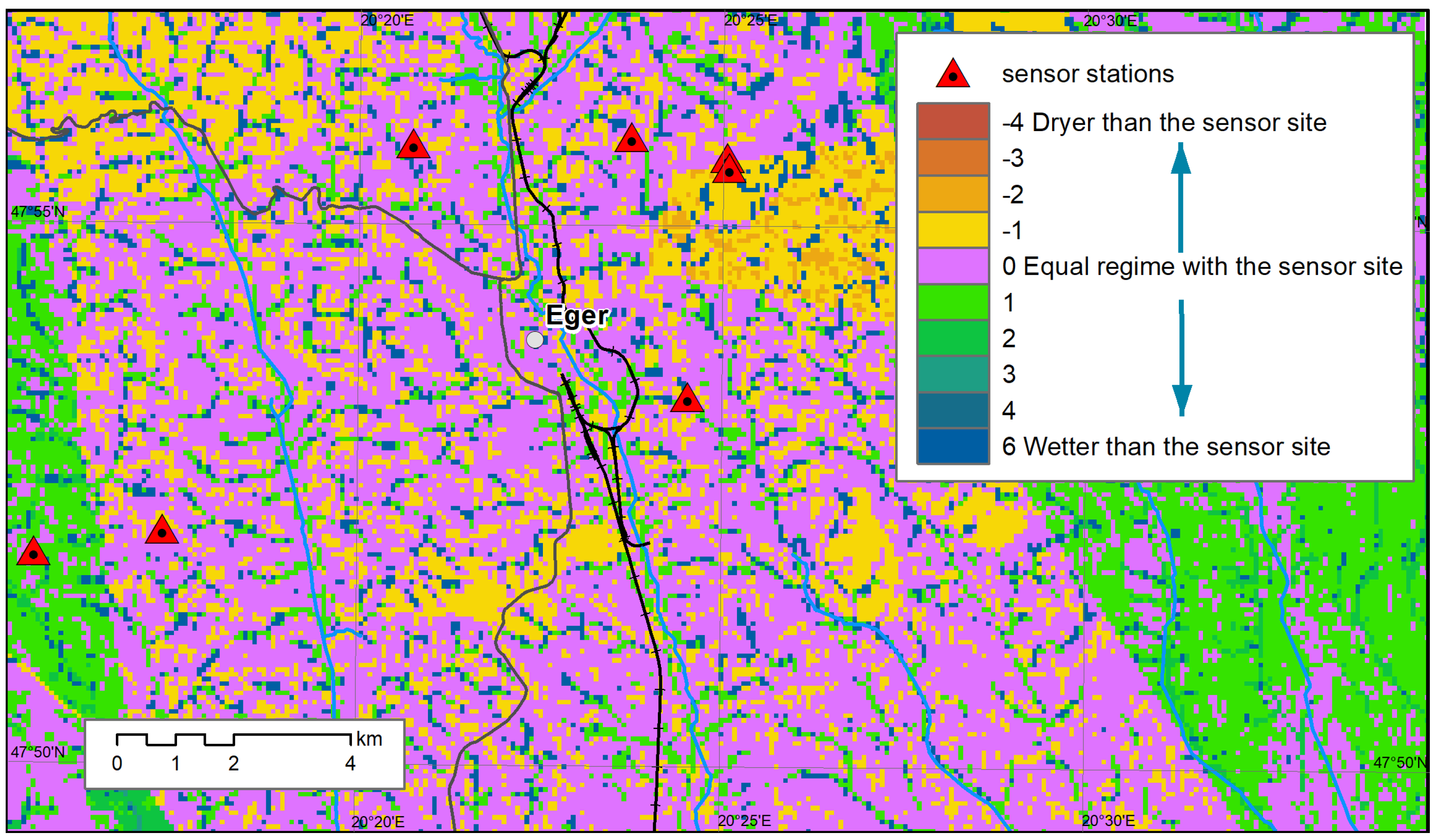
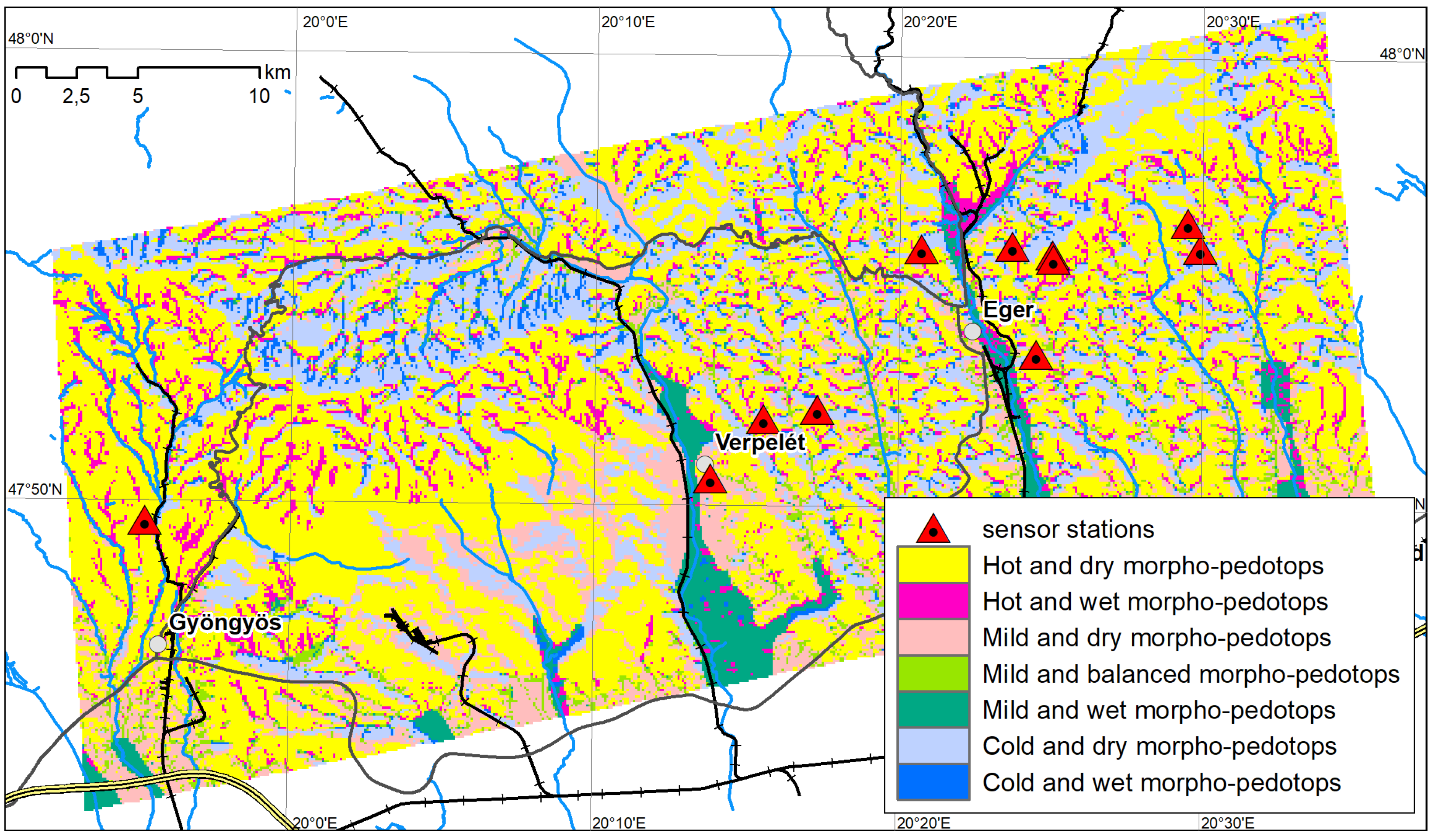
| The Analysed Index | Applied in Slovakia | Applied in Hungary | Form |
|---|---|---|---|
| Digital Terrain Model | x | x | Raster |
| Morphometric indices | |||
| Slope angle | x | x | Raster |
| Horizontal and profile (normal) curvature of the relief | x | x | Raster |
| Orientation of the relief to the cardinal points | x | x | Raster |
| Contributing area | x | x | Raster |
| Horizontal and vertical dissection of the relief | x | Raster | |
| Complex forms of the relief | x | Raster | |
| Lengths of the insolation | x | x | Raster |
| Amount of sun radiation | x | x | Raster |
| Macroclimatic indices | |||
| Average temperature | x | Raster | |
| Beginning and ending days of characteristic temperatures | x | Raster | |
| Days with frost and fog | x | Raster | |
| Cloudiness | x | Raster | |
| Abiocomplex(the values of these analytical characteristics are valid for the areas of abiocomplexes) | |||
| Altitude above the sea level of the abiotops | x | Polygon | |
| Morphological types of the relief of the abiotops | x | Polygon | |
| The slope angle of the abiotops | x | Polygon | |
| Normal and horizontal curvature of the abiotops | x | Polygon | |
| Aspect of the abiotops | x | Polygon | |
| Type and texture of the soils | x | x | Polygon |
| Depth and skeleton of the soils | x | x | Polygon |
| Moisture and fading point of the soils | x | Polygon | |
| Geological substratum complex | x | x | Polygon |
| Flow capacity coefficient of the substratum | x | Polygon | |
| Filtration coefficient k of the substratum | x | Polygon | |
| Water storability coefficient | x | Polygon | |
| Depth of the underground water | x | Polygon | |
| Complex interpreted indices | |||
| Surface run-off | x | Raster | |
| Erosion threat—potential and real | x | Raster | |
| Potential evapotranspiration—vegetation period | x | Raster | |
| Humidity balance—vegetation period | x | Raster | |
| Topographical humidity index | x | Raster | |
| The balance of the surface water run-off | x | Raster | |
| The humidity balance of the morpho-pedotops | x | Raster | |
Soil Types—MoiSture and Retention Surface Water Supply | 1—Coarse Scelet, Sands, Salty | 2—Sandy | 3—Loamy–Sandy to Sandy–Loamy | 4—Loamy to Silty–Loamy | 5—Clay–Loamy to Silty–Loamy | 6—Silty–Clay to Clay | 7—Alluvial,Gley, Salty–Gley | 8—Organic, Peat |
|---|---|---|---|---|---|---|---|---|
| 1—only outflow, dispersion, and removal | 1 | 1 | 1 | 2 | 2 | 2 | 5 | 6 |
| 2—weak prevailing outflow and removal | 1 | 1 | 2 | 2 | 3 | 3 | 5 | 6 |
| 3—balanced inflow and outflow | 1 | 2 | 2 | 3 | 3 | 4 | 5 | 6 |
| 4—moist prevailing inflow and accumulation | 1 | 2 | 3 | 3 | 4 | 4 | 5 | 6 |
| 5—wet massive inflow, accumulation | 2 | 3 | 3 | 4 | 4 | 5 | 5 | 6 |
| 6—extremely wet, only inflow | 3 | 5 | 5 | 6 | 6 | 6 | 6 | 6 |
Moisture Regime (Table 2, Figure 3) Thermal Regime (Radiation, Figure 2) | 1. Very Dry | 2. Dry | 3. Balanced | 4. Moist | 5. Wet | 6. Very Wet |
|---|---|---|---|---|---|---|
| 1. very hot | 1.1 very dry/ very hot | 1.2 | 1.3 | 1.4 | 1.5 | 1.6 very wet/ very hot |
| 2. hot | 2.1 | 2.2 | 2.3 | 2.4 | 2.5 | 2.6 |
| 3. warm | 3.1 | 3.2 | 3.3 | 3.4 | 3.5 | 3.6 |
| 4. moderately warm | 4.1 | 4.2 | 4.3 | 4.4 | 4.5 | 4.6 |
| 5. mild | 5.1 | 5.2 | 5.3 | 5.4 | 5.5 | 5.6 |
| 6. moderate cool | 6.1 | 6.2 | 6.3 | 6.4 | 6.5 | 6.6 |
| 7. cool | 7.1 | 7.2 | 7.3 | 7.4 | 7.5 | 7.6 |
| 8. cold | 8.1 | 8.2 | 8.3 | 8.4 | 8.5 | 8.6 |
| 9. very cold | 9.1 very dry/ very cold | 9.2 | 9.3 | 9.4 | 9.5 | 9.6 very wet/ very cold |
| Generalised groups of the thermal–moisture regime by words and colours. |  | |||||
| No. | The Locality of the Sensors (Region/Community) | Radiation/Moisture Combinations Table 3 | Radiation Wh·m−2 | Radiation Classes Figure 2 | Moisture Regime of the Soils Table 2 | Altitude m.a.s.l. |
|---|---|---|---|---|---|---|
| 1. | Nenince | 1.1 | 925880 | 1 | 1 | 206 |
| 2. | Tokaj DK | 1.3 | 954894 | 1 | 3 | 173 |
| 3. | Győr, Écs | 2.2 | 914129 | 2 | 2 | 206 |
| 4. | Velky Krtís, Naturalvino | 2.4 | 910636 | 2 | 4 | 254 |
| 5. | Štúrovo, Obid | 3.4 | 904202 | 3 | 4 | 159 |
| 6. | Mátra Gyongyossolymos | 3.5 | 907508 | 3 | 5 | 267 |
| 7. | Bukk Eger É | 4.2 | 889383 | 4 | 2 | 266 |
| 8. | Tokaj DNy Tarcal | 4.4 | 891092 | 4 | 4 | 101 |
| 9. | Mátra Bukk Verpelét | 5.1 | 880759 | 5 | 1 | 143 |
| 10. | Szigetsz.márton | 6.2 | 878054 | 6 | 2 | 97 |
| 11. | Zvoncin | 6.3 | 877734 | 6 | 3 | 158 |
| 12. | Szolnok | 7.6 | 876720 | 7 | 6 | 83 |
| 13. | Štúrovo Mužla J | 8.3 | 869392 | 8 | 3 | 120 |
| 14. | Štúrovo Mužla S | 8.5 | 869240 | 8 | 5 | 120 |
| 15. | Balaton É Tihany | 9.3 | 831734 | 9 | 5 | 136 |
Publisher’s Note: MDPI stays neutral with regard to jurisdictional claims in published maps and institutional affiliations. |
© 2021 by the authors. Licensee MDPI, Basel, Switzerland. This article is an open access article distributed under the terms and conditions of the Creative Commons Attribution (CC BY) license (https://creativecommons.org/licenses/by/4.0/).
Share and Cite
Miklós, L.; Kočický, D.; Izakovičová, Z.; Špinerová, A.; Miklósová, V. Compensation for the Lack of Measured Data on Decisive Cultivation Conditions in Diversified Territories without Losing Correct Information. Land 2021, 10, 940. https://doi.org/10.3390/land10090940
Miklós L, Kočický D, Izakovičová Z, Špinerová A, Miklósová V. Compensation for the Lack of Measured Data on Decisive Cultivation Conditions in Diversified Territories without Losing Correct Information. Land. 2021; 10(9):940. https://doi.org/10.3390/land10090940
Chicago/Turabian StyleMiklós, László, Dušan Kočický, Zita Izakovičová, Anna Špinerová, and Viktória Miklósová. 2021. "Compensation for the Lack of Measured Data on Decisive Cultivation Conditions in Diversified Territories without Losing Correct Information" Land 10, no. 9: 940. https://doi.org/10.3390/land10090940
APA StyleMiklós, L., Kočický, D., Izakovičová, Z., Špinerová, A., & Miklósová, V. (2021). Compensation for the Lack of Measured Data on Decisive Cultivation Conditions in Diversified Territories without Losing Correct Information. Land, 10(9), 940. https://doi.org/10.3390/land10090940






